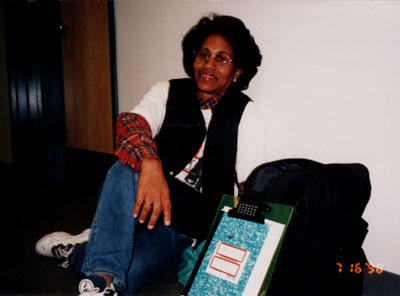
|
|
22 July, 1998
Myrtle Brijbasi
TEA/Alaska - 98
Journal Entry 13 - July 22, 1998
Alaska SeaLife Center, Ak
Good day! and welcome once again to the SeaLife Center. As usual
our routine for the day was carried out with great success. Olav and I
cleaned the outdoor lab and fed the otters, while Noa and Elisa observed
and recorded information on the otters. Since the data entry into the
computer files were very current, Noa and Elisa added the day's information
into the computer.
The otters were not displaying any kind of distinctive behaviors
worth recording and were in their dens for very long periods of time.
Therefore, there were very few observations to record. To use our time
wisely, we brain stormed on ways in which we can improve on the River Otter
Research display that was in the exhibit hall. Our ideas included an
interactive, video/TV, hands-on activity, and printed information such as
differences between river and sea otters, background information on family,
habitat, food, unique behaviors, impact of nutrient cycling on the
terrestrial environment, etc. Since we also wanted the public to recognize
a river otter, we scanned a variety of pictures of otters displaying
behaviors relative to the research that will be used in the interactive
activity.
Having observed that some of the otters were enjoying the clean
clear pool, and that there was hardly any activity by them earlier in the
day, Dr. Ben-David decided to put some fish into the large pool to see how
the otters will respond. By this time it was already 3.30 pm. She chose
six, live, large salmon (16-18 inches long and approximately 5 pounds) and
placed them into the pool. Her primary focus was diving and the speed at
which the otters will go after the fish. Olav and Susanne were equipped and
set to videotape the activity. We waited patiently for about thirty
minutes for the otters to venture into the pool. Finally, about four
otters took the plunge. Even though I stated it one of my previous journals
that they were graceful swimmers, I cannot help but emphasize that fact
again. They are beautiful to watch in water especially when they glide into
the water, lift half of their bodies and then nose dive. The appearance of
their wet, smooth, shiny coat in the water also looks pretty. After a hot
pursuit, Cabin caught the first fish, Babkin caught the second one quickly
after. As both otters brought up the fish to the platform surrounding the
pool, several otters gathered around to feast on the catch of the day. An
unidentified otter caught a third fish but failed to bring it completely
out of the water. The otter could not be bothered so it joined the other
otters to feed on the fish already caught. The fish was definitely affected
by the grab and bite of the otter, and was swimming rather slowly. We were
hoping that an otter would eventually go after the maimed fish, but none
did while we were watching. We now had more that our share of behaviors to
record. Up until we left for the day, no other otter went fishing. As we
left for the day, we each had a prediction as to how the otters will react
to the remaining fish in the pool. Who will make the right prediction? We
will find out tomorrow.

Waiting for the work day to begin.
Contact the TEA in the field at
.
If you cannot connect through your browser, copy the
TEA's e-mail address in the "To:" line of
your favorite e-mail package.
|
